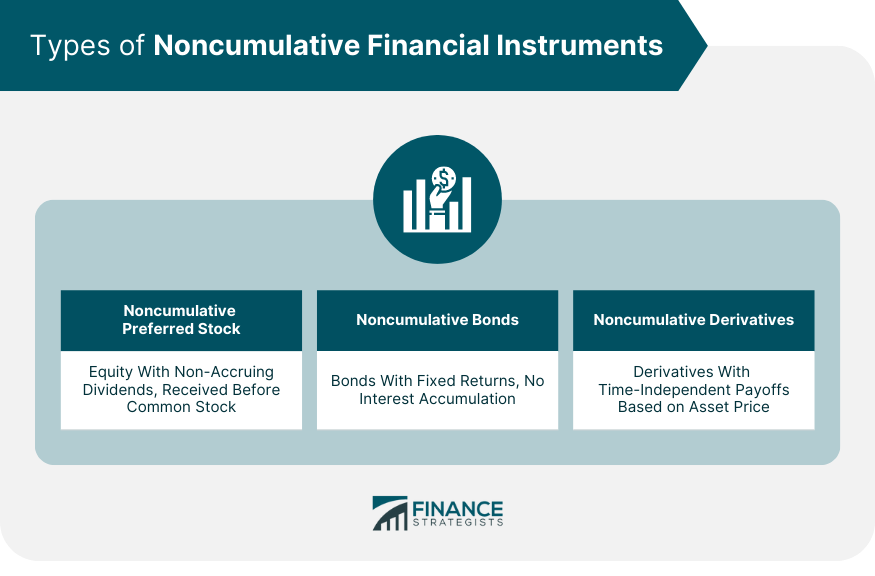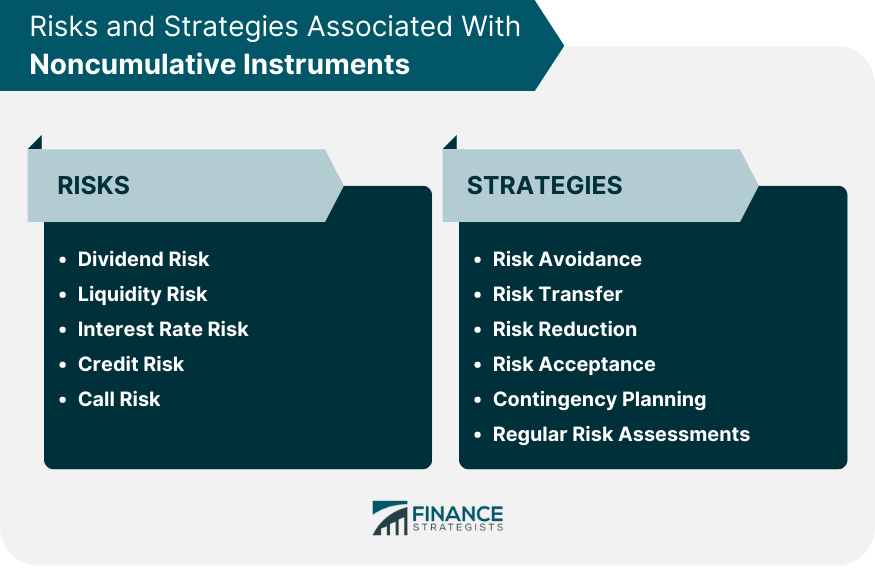Noncumulative refers to a type of policy or provision where benefits or privileges do not accumulate or carry over if they are unused within a specified period. This term is frequently employed in finance, often in relation to preferred stock dividends or insurance benefits. For instance, the noncumulative preferred stock allows for dividends that, if not declared in a given period, are forfeited by the stockholder and do not accumulate for future payment. Similarly, in insurance, noncumulative policies do not allow for the carryover of unused benefits or coverage from one period to the next. This term underscores the importance of utilizing allocated benefits within the designated timeframe. The financial world is replete with diverse financial instruments, each with unique attributes designed to cater to specific investment strategies. Noncumulative preferred stock is a unique type of equity where dividends are not accrued if they are not declared. Investors in these stocks receive dividends before common stockholders but do not have the right to receive any missed dividends. Unlike traditional bonds, noncumulative bonds do not accumulate interest over time. Instead, they offer a fixed return irrespective of the duration of the investment. Noncumulative derivatives, such as certain types of options or futures contracts, also exist. The payoff from these instruments does not accumulate over time but depends on the price of the underlying asset at a specific point in time. Noncumulative instruments are subject to securities laws and regulations. These rules ensure transparency, protect investors and maintain the integrity of the financial markets. For instance, in the U.S., the Securities and Exchange Commission (SEC) regulates the issuance and trading of these instruments. Internationally, bodies like the Financial Conduct Authority (FCA) in the UK oversee their operation. Regulators often scrutinize noncumulative instruments due to their potential misuse. Companies may be tempted to skip payments to manage short-term financial difficulties, which could harm investors. The repercussions of legal modifications can considerably affect the worth and utilization of noncumulative instruments. Legal shifts, such as amendments to financial regulations or tax laws, can alter the risk-return profile of these instruments, influencing their attractiveness to both issuers and investors. For instance, changes in regulations regarding the treatment of unpaid dividends could affect the appeal of noncumulative preferred stocks. Similarly, alterations to tax laws may impact the after-tax return for investors, modifying their investment decision. It is of paramount importance for all stakeholders - issuers, investors, and financial advisors - to stay abreast of pertinent financial legislation and changes. Noncumulative preferred stocks and bonds possess inherent risks, which must be thoroughly understood by potential investors. Here are some significant risks associated with these investment types: Dividend Risk: Noncumulative preferred stocks do not guarantee dividends. If a company skips a dividend payment, it's lost forever, as missed dividends don't accumulate for future payments. This potential income instability can be a major risk. Liquidity Risk: These stocks and bonds may not be as readily tradable as other securities, possibly limiting your ability to sell when desired. Interest Rate Risk: Bonds, including those convertible into noncumulative preferred stocks, are susceptible to interest rate fluctuations. If rates rise, bond prices typically fall, potentially leading to capital losses if the bond is sold before maturity. Credit Risk: Both preferred stocks and bonds expose investors to the issuer's creditworthiness. If the issuer experiences financial difficulty, they may default on their obligations, leading to losses for investors. Call Risk: Companies may reserve the right to buy back, or "call," their preferred stocks or bonds, typically when interest rates fall. This may limit the investment's income potential. Understanding and mitigating risks is crucial in every business scenario. Here are some effective risk mitigation strategies: Risk Avoidance: The most straightforward strategy, risk avoidance involves not engaging in activities that could carry risk. However, this often means missing potential opportunities. Risk Transfer: This involves shifting the risk to a third party. Commonly achieved through insurance, it allows businesses to manage potential financial losses. Risk Reduction: Implementing actions to reduce the severity or likelihood of a risk. This could include regular system maintenance to avoid IT system failures. Risk Acceptance: Sometimes, the cost of mitigating a risk may exceed the potential loss. In such cases, businesses might choose to accept the risk, acknowledging and preparing for potential losses. Contingency Planning: Establishing plans to address risks should they materialize. This could include backup plans, emergency funds, or alternate supply chains. Regular Risk Assessments: Regularly reviewing and assessing risks helps businesses stay updated about any changes in risk exposure and adapt strategies accordingly. Noncumulative financial instruments can exert a profound influence on a firm's balance sheet, income statement, and cash flow statement. Owing to the non-accrual nature of these instruments, the absence of accumulated dividends or interest can lead to a reduction in the company's liabilities. This, in turn, has a domino effect on the company's financial health, as it influences key financial ratios - such as debt-to-equity or current ratio - that serve as barometers of financial stability. Noncumulative instruments, comprising preferred stocks, bonds, and certain derivatives, are distinguished by their non-accrual nature, where missed payments do not carry over to subsequent periods. This financial instrument spectrum offers unique opportunities and challenges. Regulatory laws govern their issuance and trading, necessitating stakeholders to keep abreast with legislative amendments that may affect these instruments' value and use. Risks, including dividend, liquidity, interest rate, credit, and call risk, are inherent, demanding vigilant risk mitigation strategies and regular risk assessments. The impact on financial statements is significant as they can alter liabilities and key financial ratios. Definition of Noncumulative
Exploring Types of Noncumulative Financial Instruments
Noncumulative Preferred Stock
Noncumulative Bonds
Noncumulative Derivatives

Legal and Regulatory Aspects of Noncumulative Instruments
Regulatory Framework Governing Noncumulative Instruments
Regulatory Concerns
Impact of Legal Changes
Risks and Strategies Associated With Noncumulative
Risks
Risk Mitigation Strategies

Impact of Noncumulative Instruments on Financial Statements
Final Thoughts
Understanding their complexities and staying informed can help investors and financial professionals navigate this intricate financial landscape, optimize portfolio management, and unlock potential investment opportunities.
Noncumulative FAQs
Noncumulative is a term used in finance to describe a policy or provision where benefits or dividends do not accumulate or carry over if they are unused within a specified period. This concept is often applied to preferred stocks and insurance policies.
Noncumulative financial instruments can influence a firm's balance sheet, income statement, and cash flow statement. The non-accrual nature of these instruments can lead to a decrease in the company's liabilities, which can affect key financial ratios that indicate financial stability.
Noncumulative instruments are subject to securities laws and regulations, which ensure transparency, protect investors, and maintain market integrity. Organizations like the U.S. Securities and Exchange Commission (SEC) and the UK's Financial Conduct Authority (FCA) regulate these instruments. Any changes in financial regulations or tax laws can alter the risk-return profile of these instruments.
Noncumulative instruments have inherent risks, including dividend risk, liquidity risk, interest rate risk, credit risk, and call risk. Risk mitigation strategies include risk avoidance, risk transfer, risk reduction, risk acceptance, contingency planning, and regular risk assessments.
Future developments, especially in technology such as blockchain and AI, may lead to the creation of new types of noncumulative financial instruments. These advancements could potentially make these instruments more complex and efficient, providing investors with a wider array of investment opportunities.
True Tamplin is a published author, public speaker, CEO of UpDigital, and founder of Finance Strategists.
True is a Certified Educator in Personal Finance (CEPF®), author of The Handy Financial Ratios Guide, a member of the Society for Advancing Business Editing and Writing, contributes to his financial education site, Finance Strategists, and has spoken to various financial communities such as the CFA Institute, as well as university students like his Alma mater, Biola University, where he received a bachelor of science in business and data analytics.
To learn more about True, visit his personal website or view his author profiles on Amazon, Nasdaq and Forbes.











